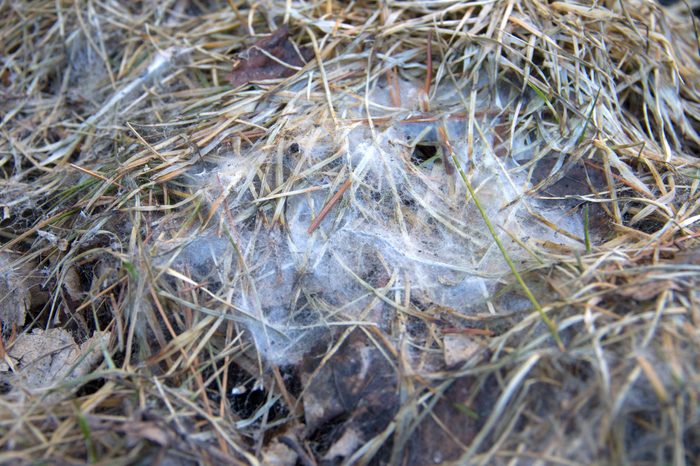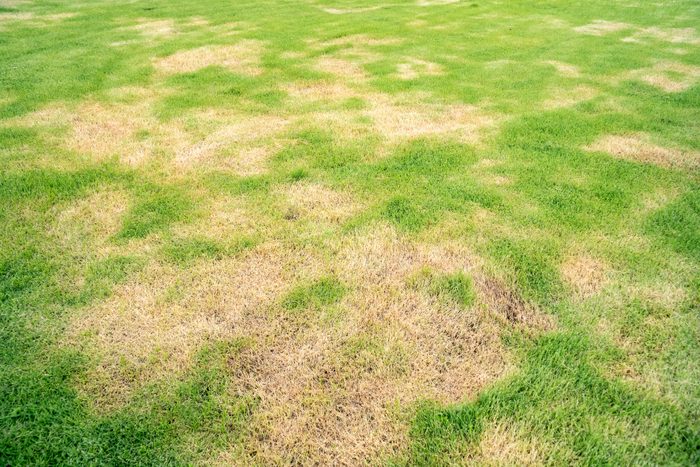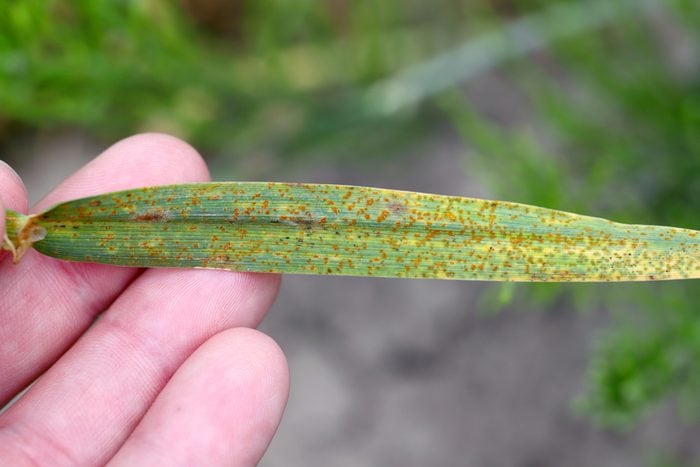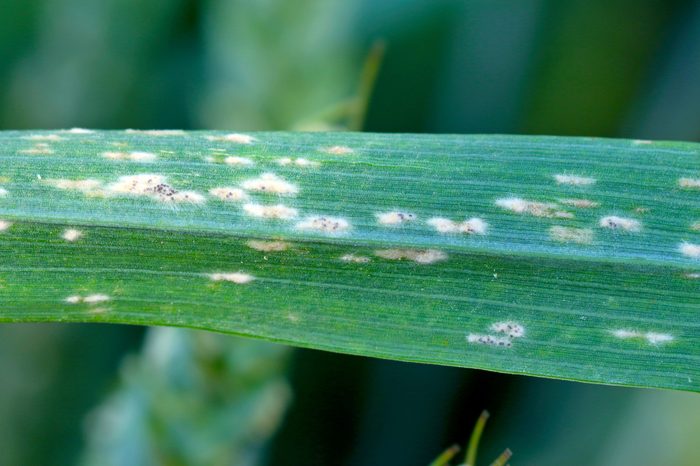
Snow Mold
Also known as:
- Pink Snow Mold (Microdochium nivale)
- Gray Snow Mold (Typhula incarnata and Typhula ishikariensis)
Where is it found?:
- Any place where it snows.
- Other regions where spring weather can be cold and wet.
What causes it?:
- Cool, wet weather during snow melt.
- Unfrozen ground.
Brief physical description:
- White or tan crusted circles that appear matted, like papier maché.
- Patches can merge into larger areas.
- Fuzzy-looking mycelia is often present.
Best way to treat or prevent:
- Do not apply fertilizer late in the fall.
- Keep grass mowed late into fall.
- When matting or mycelia appear, carefully rake and remove it.
- Chemical treatment is rarely needed.
Good to know:
- In most cases, snow mold lawn disease is cosmetic and will not cause severe lawn damage.
- It can also reappear in late spring under cool, wet conditions.
- Kentucky bluegrass, perennial ryegrass and tall fescue are the most susceptible.
- Snow Mold is a big problem on golf courses and can cause severe damage there.
Dollar Spot
Also known as:
- Scerotinia homoeocarpa
- Clarireedia jacksonii
Where is it found?:
- Throughout the U.S. in all types of lawn grass.
What causes it?:
- Not enough nitrogen fertilizer.
- Excess moisture in the soil and thatch layer.
Brief physical description:
- Clusters of small white or tan patches ranging from a few inches to a foot in diameter.
- Spots can coalesce into more prominent areas of discolored grass.
- Hour-glass lesions on individual leaf blades.
Best way to treat or prevent:
- Keep your lawn adequately fertilized, using extended-release nitrogen sources.
- by watering less often and for more extended periods of time.
- Removing dew from the grass in the early morning can also help.
- If treat it, use broad-spectrum lawn fungicides, like BioAdvanced Fungus Control for Lawns or Monterey Fungi-Max Lawn & Garden Fungicide.
Good to know:
- As is the case with managing most lawn diseases, maintaining best management practices, such as proper mowing, watering, core aeration and fertility, will go a long way in reducing the occurrence of dollar spot lawn disease.
Red Thread
Also known as:
- Laetisaria fuciformis
Where is it found?:
- Throughout the U.S. in all types of lawn grasses.
- In shady areas and other areas that remain wet.
What causes it?:
- Undernourished lawns are susceptible.
- Over-watering.
- Poor drainage.
- Prolonged overcast conditions.
Brief physical description:
- Areas appear water-soaked.
- Leaf tip dieback with red, thread-like filaments appearing.
- Irregular beige patches from a few inches to a few feet in diameter.
Best way to treat or prevent:
- Collect clippings when the disease is present.
- Apply a high-nitrogen-source fertilizer at the recommended rate.
- Disease should disappear in a couple of weeks with adequate fertilizer. If not, you can use a broad-spectrum fungicide like Scotts DiseaseX Lawn Fungicide.
Good to know:
- Red thread lawn disease often appears in spring and fall during humid, cool conditions.
- Reseeding with disease-tolerant lawn seed varieties will help.
Brown Patch
Also known as:
- Rhizoctonia solani
- Smoke Ring
Where is it found?:
- Throughout the U.S. in all types of lawn grasses.
- Tall fescue and perennial ryegrass lawns are most susceptible.
What causes it?:
- Hot, humid weather.
- Excessive fertilizer and water.
Brief physical description:
- Small to larger light-brown circular patches, most times with a very distinct outer margin.
- Irregular lesions with a purplish to brown border and tan center may show.
Best way to treat or prevent:
- Reduce nitrogen fertilizer.
- Reduce watering frequency and amount.
- Improve drainage and air circulation.
- If treatment is necessary, try Scotts DiseaseX Lawn Fungicide or a similar broad-spectrum lawn fungicide.
Good to know:
- A very widespread disease affecting most lawn grasses.
- Reseeding with disease-tolerant lawn seed will help.

Summer Patch
Also known as:
- Magnaporthe poae
- Poa Patch
Where is it found?:
- Most prevalent in northern U.S. in cool-season lawn grasses.
What causes it?:
- Prolonged hot, humid conditions.
- Compacted soils that don’t drain well.
Brief physical description:
- Can begin as small circular patches that grow into larger patches up to 18 inches in diameter. These patches can coalesce into larger areas.
- Affected areas can appear wilted, progressing into reddish-brown or light-brown sunken patches, often with a tuft of healthy grass in the patch’s center.
Best way to treat or prevent:
- Promote good root growth by core aerating and improving drainage.
- Raise mowing height to about three inches.
- Overseed with perennial ryegrass or seed new lawns with tall fescue. Both are genetically resistant.
- If treatment is desired, look for broad-spectrum fungicides like The Andersons Prosphesy Propiconazole or Jonathan Green Lawn Fungus Control.
Good to know:
- Summer patch is a root disease and, if left unchecked, can damage your lawn.
- Kentucky bluegrass and fine fescues are most susceptible.
Necrotic Ring Spot
Also known as:
- Ophiosphaerella korrae
- Frog Eye
- Patch Disease
Where is it found?:
- Mostly in northern U.S. states.
- In Kentucky bluegrass lawns.
What causes it?:
- Cool, wet weather conditions, followed by heat and drought stress.
- Over-management of your lawn (too much fertilizer and water).
- The presence of a thick thatch layer.
Brief physical description:
- Light-green to straw-colored patches usually less than 12 inches in diameter.
- Regrowth may occur in the center of the patch, creating a “frog eye” appearance.
Best way to treat or prevent:
- Reduce nitrogen fertilizer.
- Core aerate regularly to reduce soil compaction and thatch layer.
- Plant disease-tolerance seed varieties.
- Fungicide treatments can be iffy, but using a professional-grade fungicide, like Syngenta Headway G or Quali-Pro Propiconazole 14.3 will give you a fighting chance. Make sure you follow label instructions.
Good to know:
- Buying sod consisting of newer varieties resistant to this disease will help.
- Sowing your lawn from seed will reduce your odds of getting necrotic ring spot.

Leaf Rust
Also known as:
- Puccinia spp.
Where is it found?:
- Throughout the U.S. in all types of lawn grasses.
- Most commonly, on perennial ryegrass.
What causes it?:
- The most common cause is the lack of nitrogen fertilizer.
- Low soil moisture and high humidity.
- It is most problematic in late summer or early fall.
Brief physical description:
- Yellow flecks appearing on leaf blades are the first sign.
- Lawns can take on a yellow or orange tint.
- These yellow flecks advance into pustules that can burst causing orange powdery spores to release.
- These rust-colored spores can cover shoes, mowers and even pets. They are not harmful to humans or animals.
Best way to treat or prevent:
- The easiest way to get rid of it is to apply a quality lawn fertilizer, like The Andersons Professional Complete Fertilizer with Humic. For quick response, try their Green Shocker 7-1-2 Fertilizer with Humic DG. This one will give you quick results. Be sure to follow application instructions.
Good to know:
- Leaf rust is a nuisance lawn disease that causes no harm to your turf.
- A single application of nitrogen fertilizer will provide quick results.
- No fungicide applications are recommended or needed.

Powdery Mildew
Also known as:
- Erysiphe graminis
Where is it found?:
- In heavy shade.
- In slow growing lawns.
What causes it?:
- Low light intensity.
- Cooler temperatures, between 60 and 70 degrees and high humidity.
- Poor air circulation.
Brief physical description:
- Cobwebby-type growth on the upper surface of leaf blades.
- In advanced cases, leaf blades appear completely coated with talc or flour.
Best way to treat or prevent:
- Increase light penetration and air circulation by pruning or removing trees and other vegetation.
- Reduce watering if areas remain unusually wet for long periods.
- Lightly fertilize to promote foliar growth. That way you’ll remove the infected leaf blades quicker.
Good to know:
- Powdery mildew is not harmful to your lawn. There is no need to chemically treat.
- It can also show up in gardens, perennials and other ornamental plants.
